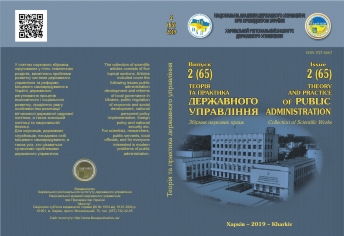Participativeness in the adoption of urban planning decisions by public administration bodies: foreign experience
Abstract
Determined the issues in the communication between developers and representatives of the territorial community, which are related to the construction process, rebuilding of engineering networks and other types of construction. Identified a number of factors that lead to the occurrence of such problems. Among them, the following can ones be highlighted: low level of community involvement in the decision-making process; insufficient interaction of the local governments with the local communities during the development of urban planning documentation and plans for its implementation; solving individual political problems, etc.
Considered some approaches to the classification of the levels of public participation in local decision making, in particular, the approach of Sh. Arnstein “A Ladder of Citizen Participation”, according to which the levels of public participation are presented in the form of a ladder, where community participation is defined by three levels (“non-participation”, “formal participation”, “real participation”) with several sublevels from the lowest level – “manipulation”, to the highest one – “public control”.
Generalized the foreign experience of participatory processes in the urban development area. Experience of the Republic of Poland and Bonn city (Germany) was analyzed on the basis of the Sh. Arnshtein’s “ladder of participation”. Was concluded that in Poland the level of public participation in the development of urban planning documentation (local development plan) is between “counseling” and “accepting” (“approving”), which corresponds to the formal “stair” of the ladder (middle level). The process of developing city-planning documentation in Bonn is at the level of “delegation of authority” and is equal to “real participation” (highest level). Both examples represent more progressive models of citizen participation compared to the current situation in Ukraine, where participation in the city planning decisions is now on the lowest levels of formal participation, and is often characterized as non-participation.
It is recommended to implement the achievements of foreign experience of public participation in the adoption of urban development decisions in Ukraine, starting from the Polish model and gradually moving to the German one.
Downloads
References
Pro reguliuvannia mistobudivnoi diialnosti: Zakon Ukrainy vid 17.02.2011 No 3038-VI (red. vid 22.02.2018). URL: http://zakon2.rada.gov.ua/laws/show/3038-17 [in Ukrainian].
Arnstein, Sherry R. (1969). A Ladder of Citizen Participation. Journal of the American Institute of Planners. 35, 4, 216–224.
Leitlinien für die Bürgerbeteiligun URL: http://www.bonn.de/rat_verwaltung_buergerdienste/buergermitwirkung/leitlinien_buergerbeteiligung/index.html.
Rowe G, Frewer L. (2005). A typology of public engagement mechanisms. Science, Technology & Human Values. 30. 251–290. URL: http://citeseerx.ist.psu.edu/viewdoc/download?doi=10.1. 1.546.7172&rep=rep1&type=pdf.
Ustawa z dnia 27 marca 2003 r. o planowaniu i zagospodarowaniu przestrzennym (Dz. U. z 2016 r. poz. 778).
Authors who publish with this journal agree to the following terms:
- Authors retain copyright and grant the journal right of first publication with the work simultaneously licensed under a Creative Commons Attribution License that allows others to share the work with an acknowledgement of the work's authorship and initial publication in this journal.
- Authors are able to enter into separate, additional contractual arrangements for the non-exclusive distribution of the journal's published version of the work (e.g., post it to an institutional repository or publish it in a book), with an acknowledgement of its initial publication in this journal.
- Authors are permitted and encouraged to post their work online (e.g., in institutional repositories or on their website) prior to and during the submission process, as it can lead to productive exchanges, as well as earlier and greater citation of published work (See The Effect of Open Access).

